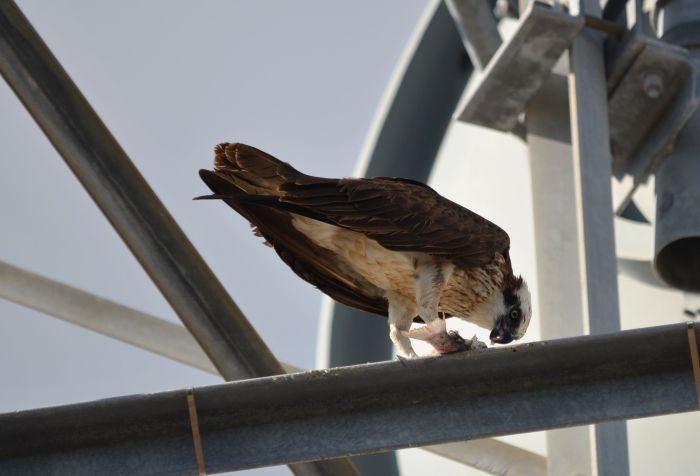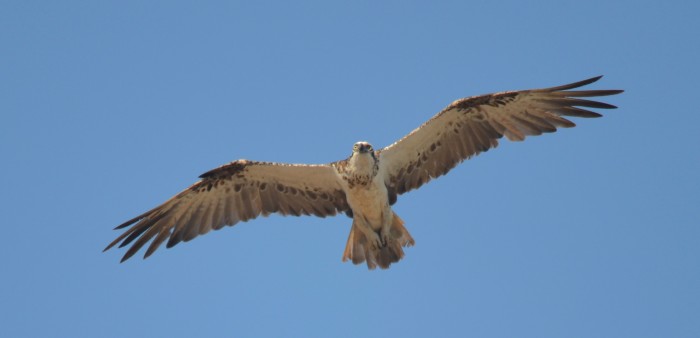When I heard the news that channel 9 was ceasing its stand-alone Darwin news bulletin I was disappointed. This station has a long history in Darwin since starting out as NTD-8 in 1971. The first local news bulletin was broadcast from Gardens Hill office in 1982 and for many years the station was the sole commercial operator in Darwin. I have fond memories of the days when there were three television stations and I turned to David Fiddler and Theona Mitaros for my Eight National News fix. The termination of the nightly local news bulletin is a sad occasion for those who care about media diversity in Darwin. Little did I realise that the closure of the Channel 9 Darwin office would have an additional tragic consequence: the removal of the broadcast tower and home to a pair of Ospreys (Pandion cristatus).
The Ospreys have been a ubiquitous presence on the Channel 9 tower for the past ten years. Whether walking along the Gardens golf course or having a beer at the ski club one could commonly sight an Osprey flying overhead, carrying either a stick for their nest or a freshly caught fish. Their plaintive, high-pitched ‘pee-ee’ calls could be easily heard from my apartment balcony overlooking the Darwin Botanic Gardens. Having these graceful fishing hawks as co-inhabitants of my suburb has been an absolute pleasure.

The Osprey occupies a niche all of its own, having apparently diverged from all other birds of prey around 24-30 million years ago. Ospreys occur throughout much of the world, with the exception of central USA, northern Africa and parts of southern Europe. This hawk had previously been categorised as a single species Pandion haliaetus, but has since been split into three species based on DNA evidence, with the Australasian population recognised as the species Eastern Osprey Pandion cristatus. The physical differences between species are minor and some taxonomists maintain that there is only one species worldwide.

Ospreys are predominantly fish-eating birds, with adaptations for catching fish by plunging into the water. Their plumage is dense to avoid soaking from water. They have preen gland near the base of the tail which contains waterproof oil. Regular preening maintains a water resistant coating that enables the bird to sometimes fully submerge itself whilst catching a fish. Osprey feet are highly adapted to holding prey, with spiky scales on the underside of talons and long curved claws. Their toes are all of the same length and the outer toe on each foot is reversible to ensure a secure grip when snatching prey.
Tropical northern Australia has a healthy population of Osprey inhabiting the coastline and offshore islands. The species is by no means threatened in Australia, and is not listed as such under the Environment Protection and Biodiversity Conservation Act (EPBC Act). However, Osprey is listed as Migratory under the act, and is therefore afforded a level of protection. So why was nothing done to assist the relocation of the Osprey nest? Surely Channel 9, or whoever was responsible for removal of the tower, has an obligation under environmental legislation to assist the Ospreys to relocate to a replacement nest in the area. A closer look at EPBC Act guidelines relating to migratory birds reveals some wriggle-room for developers (or demolishers) who can’t be bothered with the onerous task of helping animals that occupy their parcel of interest.

Under the EPBC Act a developer is required to undertake protective actions if a proposed action is deemed to have the following impacts:
- lead to substantial loss or modification of important habitat, meeting or exceeding the upper thresholds (1%) of habitat
- lead to serious disruption to an ecologically significant proportion of a population (having predicted annual mortality rates or affecting breeding cycles of a number of individuals) meeting or exceeding the upper of the thresholds (1%).
The guidelines state that an ecologically significant population of Osprey (1%) is 240 individuals. The disruption of two individuals would therefore not be considered ecologically significant. The EPBC guidelines also emphasise that the priority for conserving migratory species is to conserve their habitat. In the case of the Osprey this means the conservation of bays, estuaries, tidal stretches of large coastal rivers, mangrove swamps, coral and rock reefs and terrestrial wetlands. A large communication tower may constitute a useful nesting location, but could hardly be classified as important habitat.

It’s also worth noting that while listed as Migratory the Australian population of Osprey do not undertake regular seasonal movements. This behaviour is exhibited in the Osprey species Pandion carolinensis that breeds in North America and migrates to Central and South America during the winter months. Despite this, the cristatus species has been classified as Migratory under the BONN convention (The Convention on Migratory Species) and therefore is also classified as such under the EPBC Act.
The Ospreys status as a Migratory species has led many developers to undertake nest relocation or surrogate nest construction as part of healthy public relations for their company. In Queensland, where coastal development is rampant, the Department of Environment and Heritage Protection has even developed a manual for building Osprey nest platforms. It would have been great if such a task was undertaken following the removal of the Channel 9 tower. I now have another reason to boycott the channel other than their terrible television content!

I remain hopeful for the future of the Osprey pair in The Gardens. A week after the removal of their nesting tower I continued to hear
Osprey calls from my bedroom. A ride around the neighbourhood revealed that the birds were attempting to colonise a nearby communications at the expense of a pair of incumbent Torresian Crows (Corvus orru). I didn’t like their chances as Crows are notoriously crafty and resilient birds. However it seems that the Ospreys have won the battle and can be seen roosting on their hard-won communications tower of an evening. Breeding in 2017 may be impossible, but at least I can bring myself to occasionally watch Channel 9 news with a clear conscience.

References
Debus, S. 2012. Birds of Prey of Australia – a field Guide. CSIRO Publishing, Melbourne, Victoria.
Department of Environment (Australian Government). 2015. Referral guideline for 14 birds listed as migratory species under the EPBC Act. <http://www.environment.gov.au/system/files/resources/c05f5b87-0a99-4998-897e-7072c236cf83/files/migratory-birds-draft-referral-guideline.pdf>.
Department of Environment and Heritage Protection (Queensland Government). 2016. Osprey nest platform manual. <https://www.ehp.qld.gov.au/licences-permits/plants-animals/documents/is-wl-osprey-nest.pdf>.
Frost, P.D. 2006. Birds of Prey – majestic masters of the sky. Parragon, UK.
